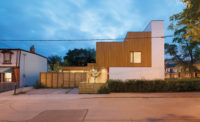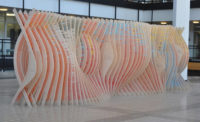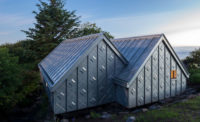Firm to Watch: Bittertang




























It would be a flagrant understatement to say that Bittertang builds. More accurately, they inflate, stuff, and smother. The resulting hallucinatory environments resemble a delightful cross between a gastroenterologist's dream and a petting zoo. Oddness aside, Bittertang is pushing the conventions of architecture by creating forms that are at once tectonic, pliable, corporeal, and damn good fun.
'Everyone talks about immersive spaces and a sensorial, visceral approach to architecture, but it's not literal enough,' says Antonio Torres, 33, one of the two founders. 'We are interested in getting architecture to be interactive and tactile,' adds his partner, Michael Loverich, 36.
The firm (they prefer to call it a 'farm') is run between New York and Guadalajara, Mexico, where Loverich and Torres respectively reside. They met in 2004 at UCLA, where they both received their M.Arch degrees, and later became roommates in New York City.

The duo was fascinated by the mood of different spaces and the puzzle of making structure from soft materials. They began messing around with digital modeling and making mutant stuffed animals to test their hypotheses. While they both worked at 'normal' firms'Loverich at Reiser-Umemoto; Torres at Johnston Marklee'the financial collapse in 2008 got them thinking seriously about turning these experiments into a business. 'We felt like we were breeding creatures,' says Loverich. Torres recalls musing, 'Maybe it's not a firm, but something else.' Their farm was born.
In 2010, the two entered the competition for the Architectural League's Prize for Young Architects. At this point, their portfolio consisted of the plush toys, an aquaponics project, and a garden. “We were like, 'Oh my gosh, we have nothing,' so we decided to put all of our ideas together,” says Loverich. They won the prize with a proposal to design Romulus and Remus, a womb-like “succulent piñata,” covered in undulating green fringe with a candy interior, festooned with small pink fetal forms. The piñata is now on view at the Graham Foundation in Chicago in an exhibition of young designers called Treatise: Why Write Alone.
Bittertang began to experiment with inflatable forms. They partnered with a manufacturer that specialized in heavy-duty inflatables for flood remediation to make pink balloon-like objects. Burble Bup, a pavilion on New York City’s Governor’s Island in summer 2011, consisted of a roof of these inflatable, doughnut-shaped “Bups” lashed together with harnesses, supported by bark-filled tubes and soil mounds to create a performance space.
For a pop-up store for menswear-designer Michael Bastian in 2013, they transformed two shipping containers inside a pier shed along Manhattan's West Side Highway into an American Gothic-esque space, the walls covered in beeswax and the exterior concealed in a haystack. “They approach spaces in a different way from most people. It's more a mood for them,” says Bastian.
The hay concept extended to an outdoor amphitheater they completed last summer in Lake Forest, Illinois. Buru Buru, as it is called, consists of a mesh membrane stuffed with hay supported by a steel frame, so that it resembles a teepee made of bratwurst. If left long enough, the pavilion would eventually degrade into compost.
When not preparing Bittertang works, Loverich teaches at the University of Pennsylvania, and Torres at the Monterrey Institute of Technology; both work on comparatively staid residential commissions. “We'd like to merge the experimental projects with traditional work to see how those can be bred,” says Torres, but “we still haven't found a crazy client who wants to go all out.”




















